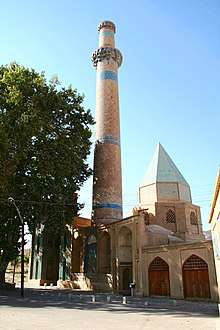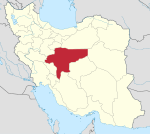Natanz
Natanz (Persian: نطنز, also romanized as Naţanz)[2] is a city and capital of Natanz County, Isfahan Province, Iran. At the 2006 census, its population was 12,060, in 3,411 families.[3] It is located 70 kilometres (43 mi) south-east of Kashan.
Natanz نطنز | |
|---|---|
City | |
 Shrine Complex of Abd al Samad, built in 1304 | |
 Natanz | |
| Coordinates: 33°30′48″N 51°54′59″E | |
| Country | |
| Province | Isfahan |
| County | Natanz |
| Bakhsh | Central |
| Population (2016 Census) | |
| • Total | 14,122[1] |
| Time zone | UTC+3:30 (IRST) |
| • Summer (DST) | UTC+4:30 (IRDT) |
Its bracing climate and locally produced fruit are well known in Iran. Its pear fruits are well known.[4] The Karkas mountain chain (Kuh-e Karkas) (meaning mountain of vultures), at an elevation of 3,899 meters, rises above the town.[5]
Various small shrines dot the area, and it is known as the shrine of Abd as-Samad.[4] The elements in the present complex date from 1304 with subsequent additions and restorations, such as the Khaneqah and Muqarnas vault. The tomb honors the Sufi Sheikh Abd al-Samad, and was built by the Sheikh's disciple, the Ilkhanid vizier Zain al-Din Mastari.
Nuclear facility

Natanz nuclear facility, located some 30 km NNW from the town (33°43′N 51°43′E) near a major highway, is generally recognized as Iran's central facility for uranium enrichment with over 19,000 gas centrifuges currently operational and nearly half of them being fed with uranium hexafluoride.[6]
Enrichment of uranium at the plant was halted in July 2004 during negotiations with European countries. In 2006, Iran announced that it would resume enrichment. In September 2007, the Iranian government announced that they had installed 3,000 centrifuges at Natanz. In 2010, the International Atomic Energy Agency (IAEA) was told by the Iranian government that future enrichment programmes would take place at Natanz, and they would start in March 2011.[7]
In January 2013, Fereydoun Abbasi from the Atomic Energy Organization of Iran said: "five percent uranium enrichment is continuing at Natanz, and we will continue 20 percent enrichment at Fordo and Natanz to meet our needs".[8]
Daily inspection by the IAEA of the Natanz site was agreed as part of the nuclear enrichment reduction agreement made with the P5+1 countries in November 2013.[9]
Between 2007–2010 Natanz nuclear power plant was hit by a sophisticated cyber attack that was carried out by German, French , British, American, Dutch and Israeli intelligence organizations. The attack used a Stuxnet worm which hampered the operation of plant's centrifuges and caused damage to them over time. The goal of the cyber attack was not to destroy the nuclear program of Iran completely but to stall it enough for sanctions and diplomacy to take effect. This was successful as a nuclear treaty with Iran was reached in July 2015.[10]
Gallery
 Natanz Stone Fortress
Natanz Stone Fortress Natanz mosque next to the old Chenar
Natanz mosque next to the old Chenar.jpg) Ancient tree of Natanz
Ancient tree of Natanz.jpg) Portal of Abd al-Samad complex
Portal of Abd al-Samad complex
See also
References
- https://www.amar.org.ir/english
- Natanz can be found at GEOnet Names Server, at this link, by opening the Advanced Search box, entering "-3076691" in the "Unique Feature Id" form, and clicking on "Search Database".
- "Census of the Islamic Republic of Iran, 1385 (2006)". Islamic Republic of Iran. Archived from the original (Excel) on 2011-11-11.
- Bamford, James. "The Secret War." Wired. June 12, 2013. "2. Retrieved on June 14, 2013.
- The place where Darius III was murdered by his relative, the satrap Bessus, is believed by historians to lie in the region of Ahevanu in Semnan province, much more to the east and north than Natanz.
- "Implementation of the NPT Safeguards Agreement and relevant provisions of Security Council Resolutions 1737 (2006), 1747 (2007) and 1803 (2008) in the Islamic Republic of Iran, September 15, 2008" (PDF). Retrieved 2012-06-19.
- "Iran's key nuclear sites". BBC News. 15 October 2013. Retrieved 25 November 2013.
- "Iran will continue 20% enrichment at Fordo, Natanz: official". Tehran Times. 9 January 2013. Archived from the original on 5 December 2013. Retrieved 25 November 2013.
- "Iran nuclear deal: Key points". BBC News. 24 November 2013. Retrieved 25 November 2013.
- "Revealed: How a secret Dutch mole aided the U.S.-Israeli Stuxnet cyberattack on Iran". Yahoo News. 2 September 2019. Retrieved 3 September 2019.
External links
| Wikimedia Commons has media related to Natanz. |
